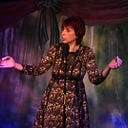To Maximize Your Impact, Tell Your Stories
“Stories are the creative conversion of life itself into a more powerful, clearer, more meaningful experience. They are the currency of human contact.” Robert McKee
There have never been so many competing demands for attention at the same time there is so much essential knowledge to communicate. For people working to help people create their lives — whether those people are clients, students, employees or children — the ability to craft and deliver a compelling story is a most effective and empowering tool to impart ideas, information or inspiration. Research into the way our brains pay and process attention provides important and effective guidelines for doing just that. Thanks science!
Well-crafted stories can frame and explain important concepts as well as engage listeners in ways that add color, imagination and emotional significance to important information and in this way make the content memorable and meaningful. “The story is actually just a delivery system for the teller’s agenda,” writes Jonathan Gotschall in Why Storytelling Is The Ultimate Weapon. “A story is a trick for sneaking a message into the fortified citadel of the human mind. Research shows that our attitudes, values, hopes and fears are strongly influenced by story…The more absorbed readers are in a story, the more the story changes them.”
Some guidelines for crafting stories that have impact:
Choose descriptive details and embed them with active imagery. The details are the scenery we want the audience to attend to, and the route we take connects them. We might start by directing attention to a specific moment in time: “Its St. Patrick’s Day, 1981, a Friday and I’m in evening rush hour traffic inching down 9th Avenue in New York City. Traffic is backed up to Connecticut, because its been raining for 3 days. And all I see in front of me are sheets and sheets of blinding rain.”
Or to a state of mind: “At about 8 pm on Memorial Day I realize I haven’t spoken to anyone in 3 days. I haven’t left my house, answered my phone or even looked out a window since Friday morning. That’s what happens when I get into the flow of painting.”
Or to a set of facts: “There are 15000 more gun shops in the United States than there are grocery stores. My home town in the midwest, with a population of 5, 450 has 5 gun shops, 4 bars and 1 grocery store. It is easier to create an arsenal than to buy groceries.”
Keep the listener’s attention focused by building the tension. When the main character’s struggle is vivid and the stakes get higher over the course of the story, the listener will remain engaged. The art of story is the capacity to sustain tension so the listener cares about what is going to happen and is present for the unfolding narrative. “ Neuroscientist Paul Zak writes that we attend to the story “because we intuitively understand that we, too, may have to face difficult tasks and we need to learn how to develop our own deep resolve. In the brain, maintaining attention produces signs of arousal: the heart and breathing speed up, stress hormones are released, and our focus is high.”
Experiment with ordering the details in different ways. Start with a high-stakes scene and then fill in the information the audience needs to understand it. Then start again with a leading statement and reveal the details chronologically. Try different routes to the same conclusion and be ready to ditch the details that do not serve the central narrative.
Know what point or idea the story illuminates and choose the details that intensify the focus on it. Tell the story to a trusted colleague and listen to their emotional response as well as what they understand to be the take-away. Find out if there are distracting or confusing details that derail the narrative and be willing to edit them.
Enter into emotional moments rather than describe them. Suppose the story is about a life-changing phone call. If the set up portion of the story successfully establishes the stakes, this is the time to bring the audience into what its like during and after the call: “Its a regular day at the office when my supervisor says there is a call for me from an editor at Penguin Books. My heart is pounding out of my chest. I can hardly breathe, I want so much for this to be good news — I need this — but I know there is a better chance it will not be good. ‘We want to publish your book,” the woman says. And I say robotically ‘you want to publish my book?” like I’m Siri. “Yes, yes that’s right,’ the woman says. Then I feel a surge of what I can only call joy juice, just a burst of dopamine in my brain. Five years of working in the dark just got a green light and I’m busting!!” If the storyteller embodies the emotion and heightens it, the listener experiences the emotional ride. Emotion and vivid imagery compels the brain to pay attention and makes the story memorable.
If possible, set up a pattern within the narrative, and return to it like the chorus in a song. A recurring image or reference grounds a narrative the way a repeating melody grounds a piece of music. The brain is very responsive to this because one of its primary purposes is to seek and identify patterns. Combined with the novelty, descriptive imagery, and unexpected twists in the narrative this is an optimal positive experience for the human brain.
Be memorable. Develop the art of story. Make an impact.
Jude Treder-Wolff, LCSW, CGP. CPAI is a consultant/trainer, writer/performer and president of Lifestaage, Inc. She is host/creator of (mostly) TRUE THINGS, a game wrapped in a storytelling show, and co-creator of MASHUP-Stories Into Song.
